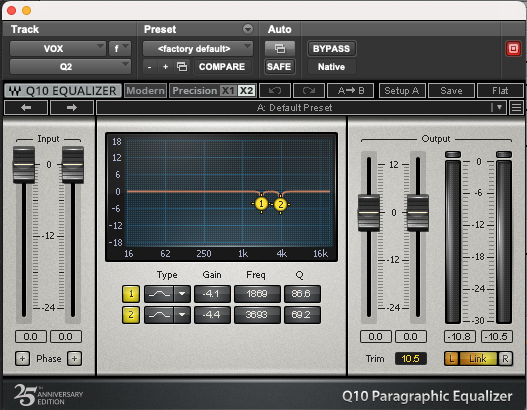Are you tired of listening to your mix in the car and wishing you had chosen a different hobby or career? All those trips back and forth are tiring! Sometimes, this happens because we get caught up on a single element of the mix, and overlook the bigger picture. When there’s a lot going on, it’s quite easy to lose perspective. Fortunately, I’ve compiled a list of things to pay attention to in your mix before you hit that export button.
1: Vocal Balance
Are the vocals dominating the mix? While vocals play a pivotal role, finding the right balance is essential. Experiment with mixing at lower volumes—this generally helps discern the optimal vocal level. If balancing volume doesn’t cut it, consider addressing other instruments’ frequency ranges to clear space for the vocals, especially in the mid and upper mids where a vocal’s body and articulation reside.
2: Vocal Smoothness
While mixing at low volume is useful for setting balances, sometimes it’s difficult to hear offending frequencies until we turn the volume up. As you’re finalizing your mix, turn up the volume to assess how smooth the vocals sound. Doing this will unveil any harshness or annoying resonant frequencies in the 1k-5k range. If you find that the vocals are sticking out too much at high volumes, determine whether drastic or subtle changes are best. Sometimes compression with a quick attack will help unruly transients- or sometimes a little notch or two with an EQ will do the trick.

After turning the song up, I noticed some harsh resonances in the vocals. A couple little notches in the upper mids was all it needed.
3: Overall EQ and Frequency Curve
Evaluate the song’s overall frequency response. Are there gaps or frequency buildups that need attention? Listen for pockets or gaps in the spectrum that require filling (or reducing) and consider if these areas need addressing based on the song. While you should always use your ears, sometimes a frequency analyzer can help shift your perspective to a different frequency range that you had not previously paid attention to. Personally speaking, I find that once in a while I tend to cut too many low mids across the tracks in order to clear space for other instruments, and this amounts to a hole in that area at the end. When this happens, I’ll add a little boost with EQ on the mix bus and the song tends to balance out.
4: Dynamics
A well-mixed song requires careful attention to dynamics. If you’re relatively happy with how the mix sounds, but feel that it lacks a bit of cohesion, utilize compression to control the dynamics. Audition different compressors to see which one is up for the job. On the mix bus I like to use multi-band compression as it allows me the ability to control each frequency range independently. Conversely, if you already have compression going on, listen to the dynamics and see if dialing it back will give the song more punch and impact.
5: Stereo Field
Ensure each element occupies its own space in the stereo field. Experiment with panning, spatial enhancers, chorus, or delay effects to achieve the desired width. If you find that you’re battling with getting two sounds to be heard over each other, sometimes making one stereo can help them sit in a different place and cut through the mix.
6: Clicks and Pops
Thoroughly address clicks and pops by splicing the waveform at the zero point between the peaks and dips (compression and rarefaction). This meticulous approach eliminates unwanted artifacts and ensures a clean artifact-free final product

7: Addressing Boredom or Lull Moments
Critically assess the track for any dull or monotonous sections. While respecting the artist’s vision, explore creative solutions such as arrangement adjustments or introducing subtle variations to maintain listener engagement. Maybe you can copy that shaker track from the verse on the second half of the final chorus to give it more energy. The key here is to listen from your audience’s perspective- what would make this song more exciting?
8: Final Check Before Bouncing
Before exporting your track, verify the appropriateness of the fade-out at the end (if any). Some songs feel better with longer fade outs, some with shorter, the key is to not forget to check it!
If you’re not mastering the song yourself, leave extra space at the end to account for any noise generated by analog-modeled plugins. This practice enables mastering engineers to analyze and mitigate noise effectively.
There are of course endless things in your mix to double check before you finalize it, but you’ll know that you’re finished when you don’t hear anything else that needs to be fixed! Feel free to use this list as a starting point, but you will eventually create one that works best for you. Hopefully this information is helpful, or at the very least saves you a couple trips to the car!
About PIVODIO™ Coach Dan Zorn
Starting as a House Music producer under the alias “Dan Ryan”, Dan Zorn quickly found his way into the Chicago Club scene. After graduating from Columbia College in 2012, Dan began engineering at Studio 11, a legendary recording studio in downtown Chicago. Having worked with major label artists signed to Universal, Warner, Atlantic, and Def Jam and being an Award-Winning Content Creator for 𝗪𝗮𝘃𝗲𝘀 𝗔𝘂𝗱𝗶𝗼 𝗮𝗻𝗱 𝗥𝗲𝘃𝗲𝗿𝗯.𝗰𝗼𝗺, it’s safe to say this is one dude who lives and breathes music. Since his time in Chicago began, Dan has grown a reputation for his unique engineering style- merging his musical production chops into every mix he works on. The result is always an end product that resonates with a high level of musical understanding and a keen sense of technical mastery – creating mixes that excite all who listen.




Leave a comment